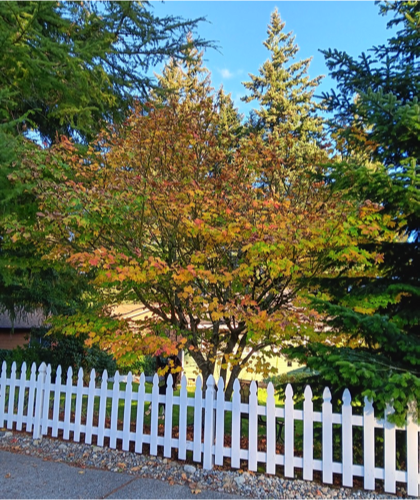
by Marilee Henry

Autumn in the PNW finds our Cascade foothills alive with brilliant hues of reds, oranges, and golds from vine maple thickets turning color, vividly contrasting with evergreen forests and rocky slopes. This deciduous, broadleaf, multi-stemmed small tree occurs in the understory of moist conifer forests, in logged clearings, and along streambanks from the coast to mid-elevations in the mountains, mostly on the west side of the Cascade crest ranging from Alaska to northern California.
Vine maple is easily recognized by its 7- to 9-lobed palmately-veined, toothed leaves with lobe points describing a circle 1 to 5 inches in diameter, and by its slender trunks with smooth grayish-green bark. Small clusters of 1 to 10 flowers with fleshy whitish disks surrounded by dark red sepals bloom in the leaf axils between March and June as bright green new leaves emerge. Flowers may be perfect, containing both male and female reproductive parts, or staminate (male) having only functional stamens. The fruits, called samaras, are 1.5 inches long, with wings spread almost horizontally to facilitate wind dispersal. Try giving a samara a quick twist on its stem between thumb and forefinger to set it "helicoptering" away!
Vine maples are a vital part of our western Washington ecosystem. Their nectar-rich flowers attract many pollinators including wasps, bees, bumblebees, butterflies, other insects, and hummingbirds. They host a whopping 133 species of moth and butterfly larvae including those of the beautiful Mourning Cloak, and Western Tiger Swallowtail. Nuthatches, chickadees, woodpeckers and other birds, and small mammals, eat the seeds. Beaver eat the bark. Deer and elk browse the foliage. The dense but flexible branch wood supplied many uses for indigenous peoples from frames for snowshoes, cradles, and fish nets, to baskets, bows and arrows, to carved implements such as bowls, platters, spoons, paddles, and spindles. Roots were boiled for a tea to treat colds; syrup was made from the sap of the largest trees.
Being shade tolerant, vine maples are often found as dense thickets among stands of Douglas fir, hemlock, and red cedar, where their fallen leaves provide significantly more nutrients to forest soils than would otherwise be provided by conifer detritus alone. The enriched soils enable other species to inhabit the forest environment, thereby enhancing biodiversity on the forest floor. Another feature of vine maples is their ability to generate new stems through basal sprouting, thereby forming multiple trunks. This creates a perfect substrate for the growth of epiphytes such as mosses, ferns, and lichens which are a crucial part of new forest formation. Epiphytes (non-parasitic plants that grow on trees) significantly contribute to forest biodiversity; the microenvironments they create provide soil, nutrients, nesting materials, shelter, and moisture for birds, amphibians, reptiles, and insects in the upper canopy where such necessities would normally be limited. The vine maple host tree can grow "canopy roots" that tap into this bounty as well! Click here for further reading on this fascinating symbiotic relationship between maples, epiphytes, and forests.
Vine maple is reported to be the most popular native tree used in PNW urban landscaping. Being the smallest of our native maples, it can grow to a maximum height of 25 to 30 ft with a spread of 25 feet, though its forms are highly variable. This tree prefers partial shade and well-drained soil, though it can thrive in sunny locations if the soil is kept moist. It can even tolerate heavy clay soils. When in shade or in the understory, it tends to become more "leggy", with leafy branches forming graceful tiers that spread horizontally, and to develop interesting twisted trunks. Autumn colors are predominantly yellows to gold. In sunnier spots it grows more upright with fewer trunks, and a bushier, denser canopy that exhibits more fiery reds and oranges in fall.
Though vine maple is closely related to Japanese maple, the latter is a native of Asia, not the PNW, and therefore is unlikely to benefit many of our native insects that are unfortunately in steep decline. Likewise, when buying a vine maple, it is important to get the native species, not a cultivar, which has been altered to please human tastes and may no longer be useful to animals that have specialized body parts or digestive systems tailored to the native plants with which they evolved.
Vine maple can be both self- and cross-pollinated, though typically few fruits are produced. Propagation by seed is difficult, requiring a long cold stratification period. Layering occurs naturally when lanky stems bend into the soil allowing root formation at nodes. Home gardeners can use layering methods as well as taking cuttings in early spring. Here are details on propagation methods for seeds and cuttings.
Vine maple is an amazingly versatile native plant. Its size especially suits it to uses in small spaces such as in bonsai or in containers for patios and balconies. Its varied forms create elegant focal points against buildings, garden structures, or among evergreens. They can be pruned or trained into many shapes to suit your own landscaping tastes while giving a boost to our local fauna. Who can't find a spot for a vine maple? Or another one?!
Remember, "You are nature's best hope!" - Doug Tallamy, author of "Nature's Best Hope" and "Bringing Nature Home".
Marilee Henry
Kirkland Community Wildlife Habitat Team Member, Washington Native Plant Society (WNPS) Native Plant Steward, Green Kirkland Steward, Finn Hill Neighborhood Alliance Contributor
Tadpole Haven open day to buy native plants. November 2nd
https://tadpolehaven.com/
Wildflowers Northwest 20% plant sale. October 29th - November 3rd
Coupon Code: Halloween20
https://www.wildflowersnw.com/?cc=HALLOWEEN20&utm_source=sqmktg_email
Eastside Audubon Plant Give-Away at Marymoor Park. November 9th
Up to 5 plants per person; please place your order by November 6th
https://www.eastsideaudubon.org/plants-for-birds
King Conservation District (KCD) plant sale information
Ordering starts November 18th
https://kingcd.org/programs/better-backyards/native-bareroot-plant-sale/
Snohomish Conservation District plant sale information
Ordering starts January 2025
https://www.theplantsale.org/